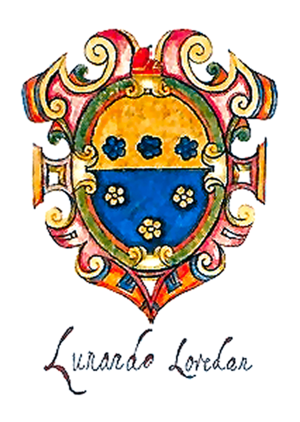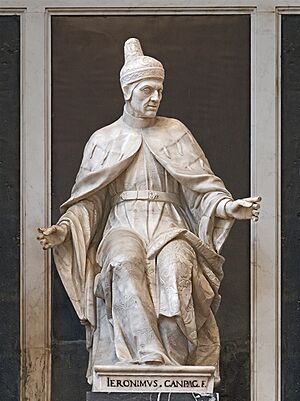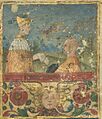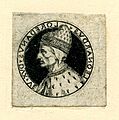Leonardo Loredan facts for kids
Quick facts for kids Leonardo Loredan |
|
|---|---|
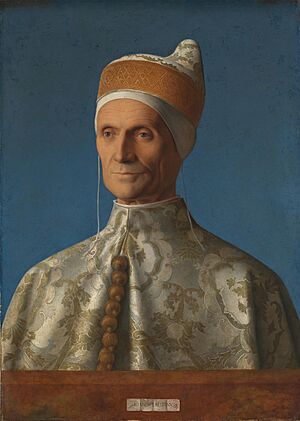
|
|
| Doge of Venice | |
| Reign | 13 October 1501 – 22 June 1521 |
| Coronation | 13 October 1501 |
| Predecessor | Agostino Barbarigo |
| Successor | Antonio Grimani |
| Born | 16 November 1436 Venice, |
| Died | 22 June 1521 (aged 84) Venice, |
| Burial | 23 June 1521 Tomb of Doge Leonardo Loredan |
| Spouse |
Morosina Giustiniani di S. Moisè
(m. 1461; died 1500) |
| Issue | Lorenzo, Girolamo, Alvise, Vincenzo, Bernardo, Donata, Maria, Paola, Elisabetta |
| Dynasty | House of Loredan |
| Father | Gerolamo Loredan di S. Vitale |
| Mother | Donata Donà di Natale |
| Religion | Roman Catholicism |
| Signature | |
Leonardo Loredan (born November 16, 1436 – died June 22, 1521) was an important Venetian nobleman and leader. He served as the 75th Doge of Venice from 1501 until his death in 1521. A Doge was like the chief magistrate or leader of the Republic of Venice.
During his time as Doge, Venice faced many challenges. Leonardo Loredan was known for his clever plans and smart political moves. He helped Venice survive tough times against powerful groups like the League of Cambrai, the Ottoman Empire, the Papal States, and the Kingdom of France. Many historians believe he was one of the most important Doges in the history of Venice.
Born into the noble Loredan family in 1436, Leonardo studied a lot when he was young. Later, he became a successful trader in Africa and the Middle East, following his family's traditions. Some stories say that a fortune-teller in Africa predicted he would become a prince in his home country. In 1461, he married Morosina Giustiniani. Her family was very influential, and some historians think this helped him become Doge later on.
Leonardo started his political career as a lawyer, dealing with money problems. He then held many important positions, like "Sage of the College" and "Procurator of Saint Mark." The Procurator was one of the highest jobs in Venice, which helped him reach the top of the government. In October 1501, he was chosen as the 75th Doge of Venice.
His rule began during a difficult war with the Ottomans, which ended in 1503 with Venice losing some land. Later, he had a disagreement with Pope Julius II over land. This led to the War of the League of Cambrai in 1509, where Venice fought against an alliance of the Pope and France. Venice lost at first, but in 1513, Loredan formed a new alliance with the French King Louis XII. This led to a big victory for Venice.
During his time as Doge, in 1516, a rule was made to formally separate the Jewish people in Venice. This led to the creation of the Venetian Ghetto, which was the first "Ghetto" in the world.
Leonardo Loredan died in June 1521. Even though his last years had some money and political issues, he was still very famous. He was buried in the Basilica of Saints John and Paul. Later, in 1572, a large and beautiful monument was built for him there.
Loredan was shown in many famous artworks. The most well-known is the Portrait of Doge Leonardo Loredan by Giovanni Bellini, painted in 1501. It is now in the National Gallery in London. Bellini also painted Loredan with his four sons in 1507. Other artists like Vittore Carpaccio and Pompeo Batoni also painted him.
Contents
Early Life and Family
Leonardo Loredan was born in Venice on November 16, 1436. He was the oldest son of Gerolamo Loredan and Donata Donà. From a young age, Leonardo was known for being very smart and good. After getting a good education, he worked as a trader in North Africa and the Levant (Middle East) to help his family's finances. A popular story says that a fortune-teller in Africa told him he would become a prince in his homeland.
Leonardo had a brother named Pietro, who was often sick and preferred studying alchemy to politics. Their father made Leonardo the main heir to the family's wealth. Leonardo also had a sister, Caterina Loredan, who later became the Dogaressa (wife of the Doge) when she married Doge Antonio Grimani, who was Leonardo's successor.
In 1461, Leonardo married Giustina Giustiniani. She came from a very rich family. They had nine children together: Lorenzo, Girolamo, Alvise, Vincenzo, Bernardo, Donata, Maria, Paola, and Elisabetta. Giustina died in 1500, a year before Leonardo became Doge. Some historians believe that his wife's powerful family helped him get elected as Doge in 1501.
Political Journey
Leonardo Loredan started his political career on December 13, 1455, when he was just 19 years old. He became a lawyer in a court that mostly dealt with financial problems and bankruptcies. A few years later, he joined the "Savi del Consiglio," where he helped review foreign policy matters before they went to the Senate.
He held many important roles, including consul of the Merchants and "Camerlengo di Comun." In 1480, he was part of a group chosen to manage money for building the church of S. Maria dei Miracoli. He was also elected "Savio di Terraferma" and helped choose the next Doge, Marco Barbarigo, in 1483.
Between 1485 and 1486, he was again appointed "Savio del Consiglio." In 1487, he became the mayor of Padua. He held this job until 1489, when he was elected to the important position of ducal councillor. In 1492, Loredan achieved one of the highest offices in Venice: Procurator of Saint Mark. This role helped him reach the very top of the state's political ladder.
As a procurator and "Savio del Consigli," he helped negotiate a big alliance in 1495. This alliance included Venice, the Pope, the Holy Roman Emperor, and the Spanish rulers. Their goal was to stop the French King Charles VIII from taking over parts of Italy. The alliance's army forced the French to leave Italy.
After Doge Agostino Barbarigo died in September 1501, Leonardo Loredan was one of the main candidates to become the next Doge. The election began on September 27 and ended on October 2, with Loredan winning. His success was partly due to his own skills and the influence of his and his wife's families.
Dogeship: Leading Venice
War with the Ottomans
When Leonardo Loredan became Doge, Venice was fighting the Second Ottoman–Venetian War. This war had started in 1499 and was going badly for Venice. They had lost a lot of land, including the important city of Modon. The war was very costly for Venice.
In 1502–1503, Loredan agreed to a peace treaty with the Ottomans. He was helped by Andrea Gritti, a Venetian who traded in Constantinople and later became Doge himself. Venice had to pay a high price for this peace, including losing land and agreeing to pay a yearly fee to the Ottomans.
The League of Cambrai War
After Pope Alexander VI died in 1503, Venice took control of some areas in the northern Papal States. When Julius II became the new Pope, Venice expected him to accept this. However, the new Pope was angry and demanded the land back. He even removed Venice from the church (excommunicated them). Venice offered to pay him, but refused to give up the cities.
In 1508, Pope Julius formed a powerful alliance called the League of Cambrai. This group included the Papal States, France, the Holy Roman Empire, and other Christian states, all against Venice.
Venice also faced problems far away. In 1509, the Battle of Diu happened in India. The Portuguese fleet defeated an Ottoman and Mamluk fleet, which had been helped by Venice. This defeat greatly hurt Venice's profitable spice trade, which had brought them a lot of money.
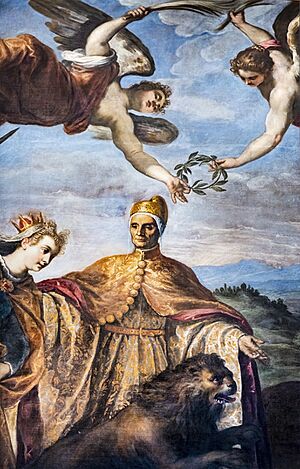
Venice lost battles to the League's forces, especially at the Battle of Agnadello. Their lands in Italy began to shrink. Even Padua, a very important city for Venice, fell. Venice itself was in danger. Loredan brought the people together, asking for their help and support. Padua was retaken, but Venice still had to agree to a peace treaty.
Later, Venice joined the Pope in a new war against the French. This alliance was almost victorious, but then a disagreement about land came up. The Emperor refused to give any Imperial land to Venice. So, Venice turned to the French King Louis XII. In 1513, they signed a treaty to divide northern Italy between France and Venice. With this alliance, Venice won a big victory over the Papal States and got back all the lands they had lost. The Pope was also forced to repay a huge amount of money to the Loredan family.
Towards the end of his rule, there were some financial issues and political problems in Venice. It's said that Loredan's family bought titles and offices for themselves, using his influence.
Leonardo Loredan's health began to decline in June 1521. He died in the night between June 20 and 21. His death was kept secret for a few hours by his children, who were busy moving furniture from his apartment.
Death and Legacy
Doge Loredan was not always in perfect health, but his strong character helped him in his government roles. In 1514, he injured his leg in a fall but continued to lead meetings. By June 14, 1521, he was too sick to attend government meetings, and his condition quickly worsened.
He died in Venice on June 22, 1521. His death was kept quiet for a few hours by his children. On June 23, his body was moved to the Doge's Palace, and his coffin was closed. A scholar named Andrea Navagero gave a speech at his funeral.
Loredan died "with great fame as a prince." He was first buried in a simple tomb in the church of Santi Giovanni e Paolo. Around 1572, a grand funeral monument was built for him in the Basilica. It has beautiful columns made of Carrara marble and a lifelike statue of him. The statue shows him bravely rising to defend Venice. Other statues on the monument represent Venice and the League of Cambrai.
Leonardo Loredan in Art
In Painting
Giovanni Bellini's portrait of Loredan is very special because it was one of the first paintings to show a Doge facing forward. Before this, most important people were shown from the side. Bellini painted this portrait in 1501–02, and it is now in the National Gallery, London.
Many years later, in 1737, Pompeo Batoni included Loredan in his large painting called The Triumph of Venice. In this artwork, Loredan represents the Doge, surrounded by figures that symbolize Venice's victory over the League of Cambrai.
-
Portrait of Doge Leonardo Loredan, by Giovanni Bellini, 1501, National Gallery, London
-
Portrait of Doge Leonardo Loredan, by Vittore Carpaccio, 1501, Museo Correr, Venice
-
Portrait of Doge Leonardo Loredan, by Gentile Bellini, 1501, Dorotheum, Vienna
-
Portrait at the Doge's Palace
-
Allegory of the Victory over the League of Cambrai, by Palma il Giovane, 1590, featuring Doge Leonardo Loredan, Doge's Palace, Venice
-
The Virgin with Child and Saints adored by Doge Leonardo Loredan, by Vincenzo Catena, 1506, Doge's Palace, Venice
-
Doge Leonardo Loredan Giving Copies of the Laws of Venice to the Ambassadors from Nuremberg, by Carlo and Gabriele Caliari, 1588, Doge's Palace, Venice
-
Print of Doge Leonardo Loredan, 18th century, British Museum, London
-
Doge Leonardo Loredan with Four Sons, by Giovanni Bellini, 1507, Gemäldegalerie, Berlin
In Sculpture
-
Statue of Doge Leonardo Loredan, by Girolamo Campagna, 1572, Basilica of Santi Giovanni e Paolo, Venice
-
Bust of Doge Leonardo Loredan, Palazzo Loredan in Campo S. Stefano, Venice
-
Bust of Doge Leonardo Loredan, by Danese Cattaneo, Birmingham Museum of Art, Birmingham
-
Doge Leonardo Loredan at the Feet of the Virgin with Saints, by Pietro Lombardo, Doge's Palace, Venice
-
Tomb of Doge Leonardo Loredan, by Girolamo Grapiglia, 1572, Basilica of Santi Giovanni e Paolo, Venice
-
Medal featuring Doge Leonardo Loredan, by Vettor Gambello, 1508, British Museum, London
See also


